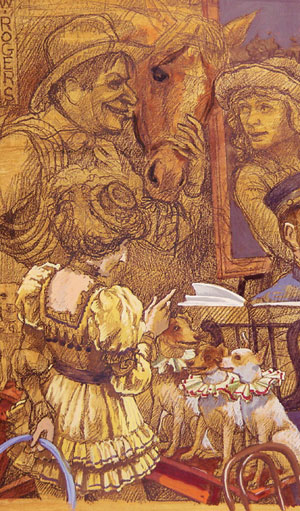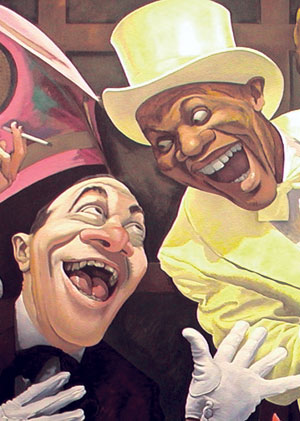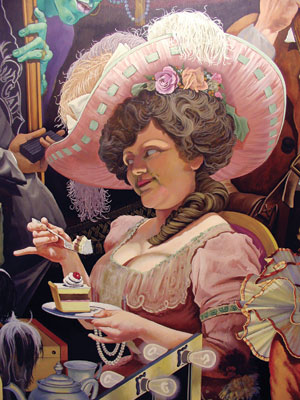



This has been a dream job. I was essentially given a creative blank check. I was never told what to do or who or what to paint. Never, did anyone say to take that person out, put this person in. Do this, change that. It wouldn’t really be possible to make it any larger, but I was never told to make it smaller . . . though some times I wish I had been. The cast of characters portrayed was also left up to me. I decided early on to restrict myself to people that only played the Theatre during its first heyday of 1895-1917. If I could not validate their appearance at the Theatre, I didn’t include them. I could not prove that Geraldine Farrar was here with the Metropolitan Opera, or that Mae West was in an Al Jolson chorus line. Martha Graham, unfortunately joined the Denishawn dancers a year too late, in 1918. So they didn’t pass the audition.
The work of a few of the performers I was familiar with. Others I had only heard of. The majority, however, were total strangers to me. Dusty, distant and colorless. I didn’t want to do a series of mug-shots or simply copy heads as I found them in photographs. I wanted my people to interact with one another and have some basis in historical fact for their interaction, no matter how tenuous or trivial. I wanted to convey the sense of a story or a narrative unfolding. This greatly increased the projects degree of difficulty, but made, I believe, for a richer viewing experience.
I chose my cast of characters based on a number of things. There were obvious, well-known choices like the three Barrymores, W. C. Fields, Will Rogers, Houdini and George M. Cohan. Others were lesser know but were included because of their association to some of these more enduring characters. Some had local ties like the producer Charles Frohman who was born in Sandusky. Others were personal favorites of mine. Like Winsor McCay who created the comic strip “Little Nemo in Slumberland” and the first animated movie called “Gertie, the Dinosaur.” I was thrilled to learn that he appeared at the Valentine Theatre, and, perhaps the only drawing of him actually doing his vaudeville act, was made by a “Blade” staff artist. Others, I included because I felt a personal kinship with them, respected their work ethic or was touched by the drama of their lives. One such figure was the tempestuous Jeanne Eagels who preferred the company of stagehands to her fellow stars, and, who, even when destitute, wouldn’t take a role unless she thought it worthy of herself and believed she could do it justice. These were ALL extremely talented people, living extraordinary lives. I hope I have conveyed the way dusty black and white photos became, for me, vivid, colorful, living and breathing people.
For me the painting exists to entertain more than to inform. To engage rather than to educate. If it ends up doing all of these, even better. What I most want it to do is convey a certain spirit. There are several anonymous figures in the painting who play supporting roles in simply creating a sense of back-stage activity.
I was not trained as a painter. I have never even watched someone else squeeze paint from a tube. Nor am I a portrait artist. So I was finding my way as I went along. There were missteps, backtracking and never-ending refinements. Creation is rarely a linear process. In this case it was labyrinthine. Working with people who understood the complexities of the creative process and that art often takes time was wonderful. I cannot thank the committee enough for their patience.
What I find most satisfying about this project is that it was a private initiative by Toledo citizens, paid for with a wide variety of private donations from a large group of Toledoans and painted by a Toledo artist.
I was privileged by the opportunity this painting afforded me and honored by the trust placed in me. Many thanks to the Board of the Toledo Cultural Arts Center and the Staff of The Valentine Theatre.
— Paul Geiger, Mural Artist




